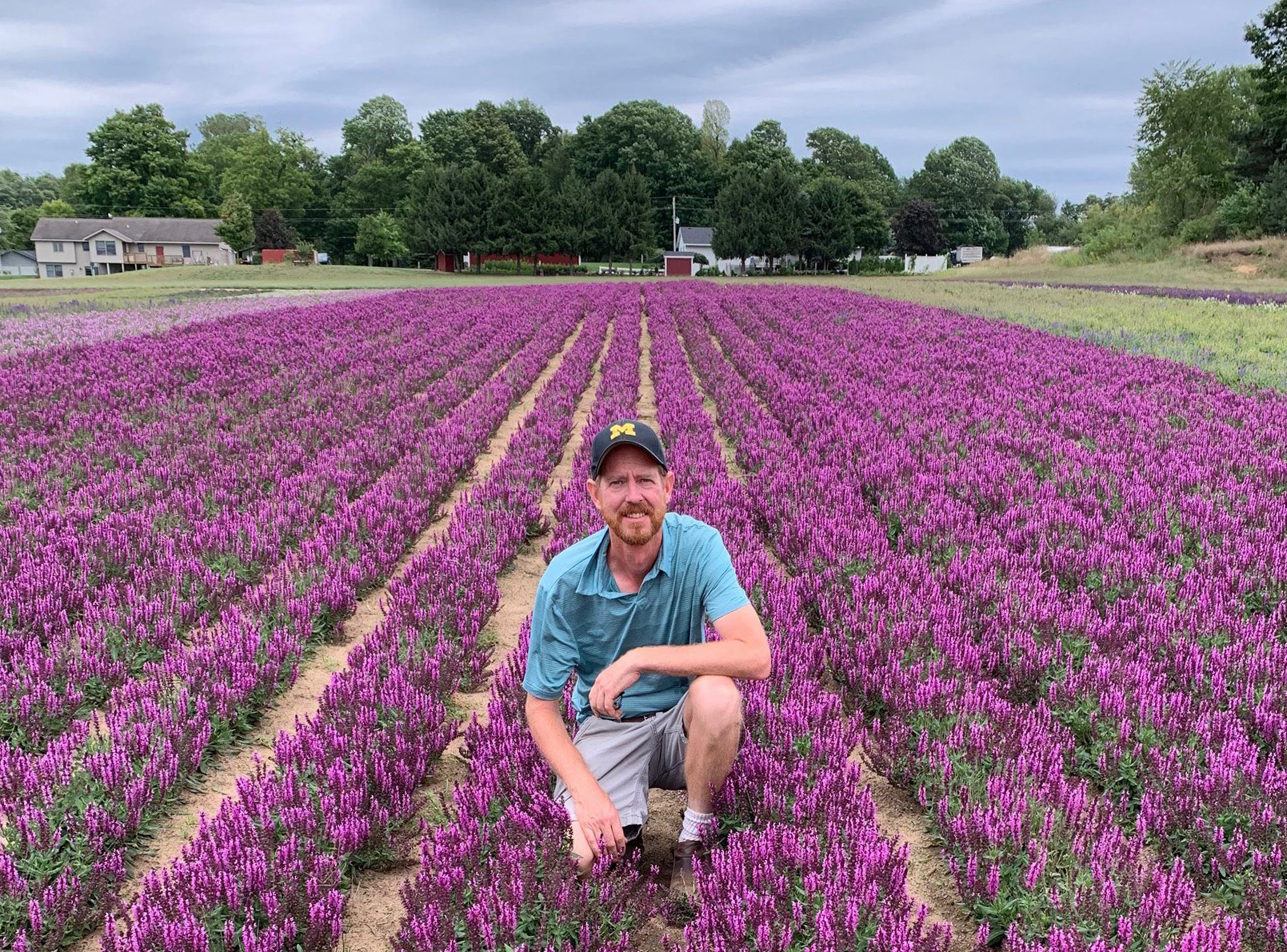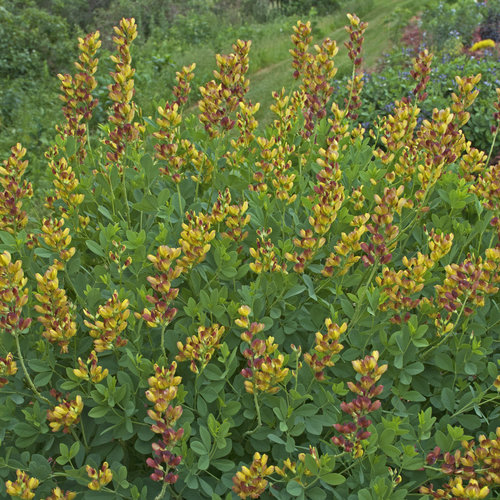Hybridizing Perennials – An Interview with Plant Breeder Hans Hansen
Have you ever wondered how the perennials blooming in your garden came to be? The world of plant hybridizing is fascinating and complex, and we’re ready to give you some insight into the process. Enjoy this interview with the lead hybridizer of many Proven Winners perennials, Hans Hansen.

Hybridizer Hans Hansen in a field of ‘Pink Profusion’ perennial salvia
Have you ever wondered how the perennials blooming in your garden came to be? The world of plant hybridizing is fascinating and complex, and once you get a peek at it, you may come to appreciate your plants even more. You might even want to explore a career in horticulture! (Did you know Proven Winners offers scholarships for that?)
We interviewed Hans Hansen (AKA @plantsplantsen), Director of New Plant Development for our perennial partner Walters Gardens, Inc. in Zeeland, Michigan, to discuss the history behind Proven Winners perennials and explore what makes some of our most popular plants so unique. Here is what he had to say.
Q: When did Walters Gardens begin hybridizing perennials for Proven Winners?
A: Walters Gardens’ perennial breeding program began in 2004, but it really started full swing after I joined the company in 2009. A focus on hybridizing premium perennial varieties that could be offered under the Proven Winners brand name was born around that time and is still going strong today.
Q: What is Walters Gardens’ goal in hybridizing new perennials?
A: We are breeding in over 70 genera today, with our team of hybridizers making thousands of new crosses each year. A primary focus is breeding cultivars of native perennials including Echinacea, Monarda, Phlox, Baptisia, Hibiscus, Heuchera, and ornamental grasses.
We are looking for perennials that are revolutionary and gamechangers rather than slight improvements to what’s already available. We want our perennial introductions to be the total package: great habit, great foliage, good flowers, and a long season of appeal for great garden value. To date, nearly 200 perennial varieties from Walters’ breeding program have been offered by Proven Winners.

Look for Dolce®, Primo® and Dressed Up™ series of Heuchera from Proven Winners.
Q: How long does it take to hybridize a new perennial?
A: It takes longer than you might think to hybridize a new plant and bring it to market. Though the exact timing varies by genus, it’s never a quick process. Sometimes, modern technology assists in moving things forward more quickly, shaving off a few months here and there.
Perennials like hibiscus that are fairly quick to mature will take about six years from seed to retail ready stage. New hosta varieties average 10 to 15 years to introduce. Since daylilies must be produced traditionally by division to maintain their true characteristics, a new variety may take as long as 17 years from the time it is selected to the time it is ready for retail. It takes a lot of patience to hybridize perennials!

A field of red hot poker Kniphofia blooming in Walters Gardens’ production fields in West Michigan.
Q: Do you trial Proven Winners perennials before you introduce them?
A: Absolutely. First, you can see from how long it takes to introduce a new variety that we have been watching it closely in our zone 6 Michigan trials for many years. Once we are quite confident that we’ve developed something special, it is trialed at Proven Winners partner Pleasant View Gardens in Loudon, New Hampshire and at several independent university trial gardens from Minnesota to Texas.
For plants like Kniphofia, Agapanthus or Agastache where cold hardiness needs to be tested for several years, they are sent to multiple trial sites for data collection. For example, some Agapanthus from 2010 crosses are still being grown in our zone 6 trials today, so we are certain they are hardy.
The three stages of plant trials before introduction are: landscape comparison trials, container growing trials, and production trials. A new plant must pass all three with flying colors before it can be officially selected and produced for retail.

Q: What is your favorite perennial you’ve ever hybridized?
A: It is so hard to choose! I’ll tell you about three of my favorites: ‘Cat’s Pajamas’ catmint (Nepeta), Shadowland® ‘Diamond Lake’ hosta and Summerific® ‘Edge of Night’ hibiscus.
I like ‘Cat’s Pajamas’ catmint because it is early to flower, is a very tough, hardy plant, looks great in a container for retail, and has a compact, refined habit. It is a game changer for folks in the nursery business because it flowers two weeks earlier than traditional catmints.
‘Diamond Lake’ is a very vigorous, blue hosta with a more rapid growth rate than many other cultivars. That makes it good for growers, but also great for garden performance because you get a larger plant faster. From a hybridizer’s perspective, it is a great achievement because it combines so many desirable traits like a rippled margin, strong and long-lasting blue color, puckered texture, and a nicely mounded shape.
I couldn’t leave out ‘Edge of Night’ hibiscus, coming to retail in 2022. It is a near-black leaf hibiscus with a habit that is so compact, it is suitable for growing near the front of the garden rather than being relegated to the back like many others. And of course, it has lovely 7” to 8” diameter, pink flowers.
KEY IMPROVEMENTS IN PERENNIALS
Q: Hans, let’s talk about three genera of perennials where you feel you’ve made the greatest impact in the line of Proven Winners perennials. Tell us about your hybridizing goals and where these plants will thrive for home gardeners.
Perennial Hibiscus Breeding (AKA Rose Mallow)

Hans and his team’s extensive breeding work with perennial hibiscus over the years has earned Walters Gardens the top spot in this class today. They have amassed a huge pool of Hibiscus genetics from which many of the most remarkable introductions in the U.S. have sprouted including Proven Winners' Summerific® series. Walters has also become the largest grower of bare root Hibiscus in the country, with dozens of acres dedicated to these crops every year.
Hybridizing Goals:
- Foliage that looks great all season, especially those with very dark purple, olive green and reddish bronze leaves
- High bud and flower count with blossoms covering the plants from top to bottom
- Flowers with thick, puckered petals that overlap and open flat
- Broad range of flower colors and patterns
- Bushy, compact plants in the 3-5’ range, suitable for the average-sized city lot
It’s interesting to note that all of the hibiscus species we work with in our crosses are native to the U.S.—one is even native to within five miles of our nursery in Zeeland, MI. Some of the nicest hibiscus plants I’ve seen growing in landscapes are in the Midwest, East Coast and Southeast. They thrive in the sun, heat and humidity in zones 4-9 and bloom when many other perennials are starting to wind down for the season.
Hybrid Phlox Breeding

Most gardeners are familiar with tall garden phlox (Phlox paniculata) and spring creeping phlox (Phlox subulata), but Hans’ most significant contribution to the genus is with hybrid phlox, which is a mix of several species, all of which are native to North America.
Hybridizing Goals:
- Far greater resistance to powdery mildew
- Early to flower, usually the second week of June in Michigan which is many weeks earlier than tall garden phlox
- Reblooming cultivars that flower again in late summer if cut back after the first round of bloom
- Polished garden habit ranging from 18-28” tall
Opening Act varieties of hybrid phlox make beautiful garden plants in full sun to part sun in zones 4-8 where they spread slowly by stolons to form a broad patch. Bees, butterflies and hummingbirds all love phlox. In the South, they can bloom as early as late April. In the North, they start blooming in June and rebloom sporadically all summer.
Native Baptisia Breeding

One of the longest hybridizing projects Hans has ever pursued is Baptisia, with crosses dating back to 1997, long before he joined Walters Gardens. When he began, the only Baptisia that was readily available to gardeners was the native species, Baptisia australis. Today, thanks to the extensive work Hans has done with the genus, Baptisia flowers now bloom in shades of violet blue, burgundy, chocolate, yellow, white, butterscotch, pink and bicolors in the Decadence® and Decadence Deluxe series from Proven Winners.
Hybridizing Goals:
- Bushy, compact plants suitable for urban gardens
- Foliage that starts lower on the stems to cover more of the bare base
- Broad array of flower colors
- Long flower spikes displayed well above the foliage, some with dark stems
- Longer season of bloom
- Later blooming cultivars to extend their season further into summer
Baptisia are among the most drought tolerant native perennials you’ll find. Several species can be found growing in the wild from Minnesota south to Texas and along much of the East Coast. Because they need a cold winter’s rest to be able to bloom again the following spring (a process called “vernalization”), they aren’t as well-suited to warmer climates, but they will grow in zones 4-9.
These perennials mature to the size of a 3-4’ tall shrub, then die back to the ground each winter, only to return even bigger and better the following spring. In most climates, they grow best in full sun, but a bit of afternoon shade can help preserve the flowers longer in the South.
Did you know that so much time and effort goes into hybridizing perennials? It truly is a life’s work for Hans and others like him. Knowing the stories behind the plants make them all the more dear to us. We hope you love your Proven Winners perennials as much as we do!
Go further:




